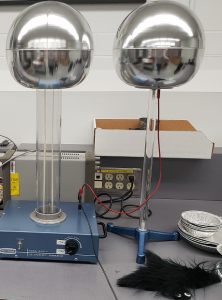Objective:
– To show charge generation using a Van de Graaff Generator.
Comment:
The bat
used in this experiment replaces the need to have a student volunteer as a charged object.
Apparatus:
- Van-de-Graaf generator
- Model bat/hair
- Small Aluminum Pie Plates
- Large Aluminum Pie Plates
- Styrofoam block/step

Method for Bat Activator
Set up the generator and insulated sphere with a separation 15 to 20 cm. Connect a grounding lead between the insulated sphere and the base of the generator.
Note:
- The insulated sphere is used to increase the capacity of the system. An increased capacity will increase the amount of charge accumulated and therefore enhance the effects one wishes to demonstrate.
- One should avoid touching the spheres or their Lucite supports. Contamination resulting from such touching will cause unacceptable electrical leakage during charging.
- Please turn off the power when not in use to prevent the machine from overheating.
Place the bat on the sphere of the generator, with the head towards the class. Switch on the generator and adjust the speed. Within a few seconds the hair
of the bat will stand on end, then the head and tail will lift and finally the bat will fly off the sphere. To achieve flight the humidity needs to be fairly low and the sphere separation just right. If the spheres are to close together arcing will occur and if too far apart the capacitance too low.
Method for Aluminum Pie Plates
Place the aluminum pie plates on the sphere of the generator. Switch on the generator and adjust the speed. Within a few seconds the pie plates will repel each other after acquiring a like charge.
Charge Demo: Van de Graaff Generator
– Video Created at Utah State University by Professor Boyd F. Edwards and assistants.
How does a Van de Graaff Generator work?
– Video created by Michael de Podesta from the National Physical Laboratory